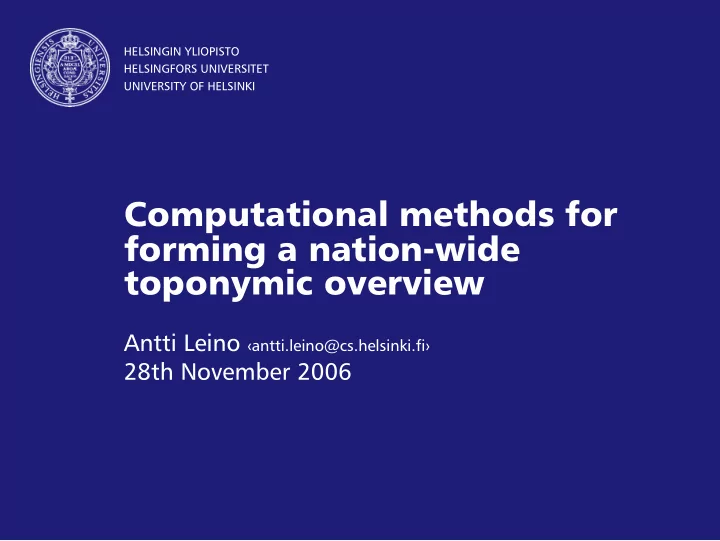

HELSINGIN YLIOPISTO HELSINGFORS UNIVERSITET UNIVERSITY OF HELSINKI Computational methods for forming a nation-wide toponymic overview Antti Leino ‹antti.leino@cs.helsinki.fi› 28th November 2006
Introduction So many names, so little time Lots of place names in a country Finnish 1:20 000 Basic Map has – c. 800 000 named places – c. 360 000 different names Not feasible to study 360 000 distribution maps How to present the overall variation?
Introduction What can we do? Data mining Sub-field of computer science Goal: find interesting new information in large collections of data Here: some examples of what can be done Visualisation Computational analysis Choice of tools depends on the data
Introduction Languages in Finland Two official languages Finnish (91.64 %) Swedish (5.50 %) Five semi-official languages Sámi languages (0.03 %) – Northern Sámi – Enare Sámi – Skolt Sámi Romany Finnish sign language Finnish, Swedish and the Sámi languages are used on maps
Introduction Getting to know the data Place Name Register Kept by the National Land Survey Part of the map-making process Language Names Places Finnish 303 626 717 747 Swedish 48 319 74 726 Northern Sámi 4 115 4 529 Enare Sámi 3 306 3 774 Skolt Sámi 141 148 Total 359 507 800 924
Languages in Toponyms Visualisation Simple way to visualise the different languages: Divide the contry into 20 × 20 km squares Count the place names in each language in each square Display these on a map Variation: how many % of the square’s toponyms are in each of the languages? Computationally easy, good first step
Languages in Toponyms Finnish Absolute Relative max=2246 max=100 %
Languages in Toponyms Swedish Absolute Relative max=1597 max=100 %
Languages in Toponyms Northern Sámi Absolute Relative max=234 max=100 %
Languages in Toponyms Enare Sámi Absolute Relative max=285 max=65 %
Languages in Toponyms Skolt Sámi Absolute Relative max=23 max=14 %
Languages in Toponyms So what? Finnish is a clear majority language This is reflected in place names So few Sámi toponyms that a more thorough onomastic overview is not meaningful With Swedish such an overview could be useful Finnish names used here to illustrate further methods
Variation in Names Goal: summarise most notable aspects of variation Most common names in different regions Computationally and conceptually easy Not always very informative Underlying components that explain the variation Sophisticated statistical / computational methods Not always intuitive Can be more informative
Variation in Names Most Common Names Divide country to e.g. 150 × 150 km squares Write on map the most common names Variant: name elements instead of complete names Finnish names often consist of two parts, e.g. Mustalampi : musta ’black’ + lampi ’pond’ Last elements shows the type of place First part describes / identifies the place
Variation in Names Most Common Names All Natural Features
Variation in Names Most Common Name Elements First Last
Onomastic Regions How to find? Goal: present regional toponymic variation concisely Concise: at most 10–20 maps Two main alternatives Clustering Component / Factor Analysis
Onomastic Regions Clustering Overall goal: divide the data into groups ( ≈ regions) so that Data items ( ≈ municipalities / grid cells) in the same cluster as similar as possible Those in different clusters as different as possible Problematic for linguistic variation in general Variation is gradual, no clear borders between regions Especially so for toponyms
Onomastic Regions Component and Factor Analysis Goal: find factors that explain the overall variation Analogy: traditional dialectology Determine dialect borders by combining individual isoglosses The isoglosses are weighted: some features are considered more important than others Here, the same thing but automatically Distributions of different toponyms are combined The weight of each toponym is determined so that the overall division is maximally clear
Onomastic Regions Non-negative Matrix Factorisation Designed for non-negative data This applies here: the number of names in a region ≥ 0 Pretty much the same results as with traditional Factor Analysis Computationally much faster By no means the only method available Use one you (or your pet data analyst) are comfortable with
Onomastic Regions Regions in Finland NMF applied to three different data sets All names on the 1:20 000 Basic Map name ≡ ( written form , type of place , language ) First parts of at most two-part names in Finnish: Musta lampi Last parts of at least two-part names in Finnish: Musta lampi 40 × 40 km squares, occurrence of names in a square as 1/0 Factors shown as maps Result: ‘regions’ as diffusion patterns
Onomastic Regions Finland Proper All Finnish Finnish names first parts last parts
Onomastic Regions Tavastia All Finnish Finnish names first parts last parts
Onomastic Regions Southern Carelia All Finnish Finnish names first parts last parts
Onomastic Regions Northern Carelia All Finnish Finnish names first parts last parts
Onomastic Regions Savonia All Finnish Finnish names first parts last parts
Onomastic Regions Western Savonia / old Tavastian wilderness All Finnish Finnish names first parts last parts
Onomastic Regions Southern Ostrobothnia All Finnish Finnish names first parts last parts
Onomastic Regions Central / Northern Ostrobothnia All Finnish Finnish names first parts last parts
Onomastic Regions Kainuu All Finnish Finnish names first parts last parts
Onomastic Regions Lapland All Finnish Finnish names first parts last parts
Onomastic Regions Swedish-language coast All Finnish Finnish names first parts last parts
Summary Some processing is required to get a one-glance overview of a large onomastic corpus There are various computational methods that can be used Name counts for grid cells Most common names / elements in grid cells Factor analysis Plenty of others Visualisation in the form of maps Choice of tools depends on the goals of the onomastic study
Thank you
Recommend
More recommend